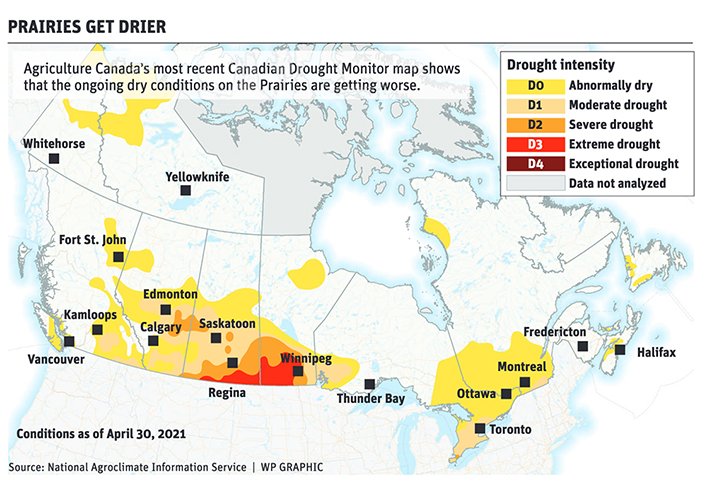‘We are not in dire straits yet’

But rain is needed | Farmers across Western Canada face dry conditions and little subsoil moisture: ‘a rain within the next two weeks would be great’
ST. FRANCOIS XAVIER, Man. — As his daughter Fiona passes with the seeder, Gunter Jochum has his knee on the ground and his eyes and finger on a smaller but even more vital farming structure: the soil.
“It’s moist right to the very top,” he says with approval of this patch of wheat-stubble-covered soil that just received canola seed.
But a few metres away his finger has to dig through a thin layer of dry soil to get into some moisture. It’s where he worked the field last year to fix ruts left from previous wet conditions.
The soil is covered by enough trash to prevent any blowing, even on a day of strong wind like this, but not enough to prevent the dryness from reaching down into the seed bed.
“There’s a real difference,” he notes. “We are not in dire straits yet, but a rain within the next two weeks would be great.”
That’s a situation facing thousands of farmers across Western Canada, as years of dry conditions have left little subsoil moisture, and a dry spring has allowed crops to go in with lightning speed, but with no moisture reserves to get it much beyond germinating, if that.
“We certainly would like to see some rain very quickly,” said Bruce Burnett, director of weather and markets information for MarketsFarm, in an interview.
“A lot of the cereal crops… have been in the ground for a week to 10 days now and would like to see some moisture to get things started.”
Canola crops are being seeded mostly behind cereals, so most haven’t been sitting stranded in dry soils, but their ability to withstand dryness is less so as soon as they’re in they’ll be needing rain in most areas.
“We do need to see a rain here,” said Burnett about the eastern Prairies, which have seen almost no moisture since the April snowstorm that hit most of Western Canada.
On the weekend of May 8-9 much of Alberta’s farm country received 15-30 millimetres of rain, which is expected to paper over the dryness faced by recently seeded crops.
Parts of western Saskatchewan also received the light rainfall.
But much of the Prairies has been missed. Farmers with seeded crops have been awaiting the rainfall hoped for on the May 14-16 weekend.
For areas with great seeding conditions but little subsoil moisture there’s a mixture of relief and anxiety. Few farmers are having to be pulled out of the mud because there’s almost no mud out there. Seeders are placing crops with great uniformity because the wheels are staying mud-free and allowing the rigs to operate almost ideally.
But the need for steady rains following seeding and until near harvest is a growing reality for most, with no moisture reserves to fall back on.
“We are going to need to see regular rains throughout the growing season,” said Burnett.
That’s already a factor in the markets, although it can be hard to winkle out from the overwhelming noise of the worldwide commodity bull market taking almost all crop prices sky-high.
For some crops, Western Canada is the primary source of supply for global exportable supplies, so anything that helps or hinders crops here can have an outsized impact on world prices.
“I think we’re setting ourselves up for a pretty volatile trading period,” said Burnett about canola prices, which are mostly based on western Canadian production.
Crops like lentils and durum are also heavily prairie-dependent for price trends, so the markets will be watching the western Canadian weather closely.
Social media is filled with photos and video of farmers busily seeding, with happy commentary about how well #plant21 has been going. Comments about needing rain are also commonplace.
Less evident is the relief in many areas from the lack of flooding, which can also be commonplace in some years.
In southeastern Manitoba, where some of the Prairies’ worst dryness is now prevalent, this time of the year is sometimes dominated by the disruptions caused by the flooding of the Red, Assiniboine and Souris rivers, which at points can spread kilometres wide and take weeks to subside.
The Jochum family lives near the banks of the Assiniboine and in an area regularly flooded, but this year the river is sitting low, bereft of the floodwaters usually gifted it by melting snow and spring rains. Further west, at Portage la Prairie, is the manmade channel that sends floodwaters surging north to Lake Manitoba in bad years, and which can flood thousands of acres of grazing land relied upon by dozens of cattle producers. That’s something nobody’s worrying about this year.
With decent post-seeding rainfall, much of today’s lingering anxiety about dryness will be staved off and farmers might feel that they’re off to a good growing season.
But with such little subsoil moisture to fall back on, farmers will be keeping one eye on the growing crops, and one a few inches beneath the surface, at the hidden resource that the crops can’t do without.


